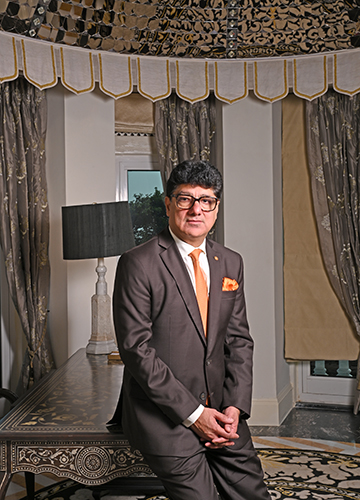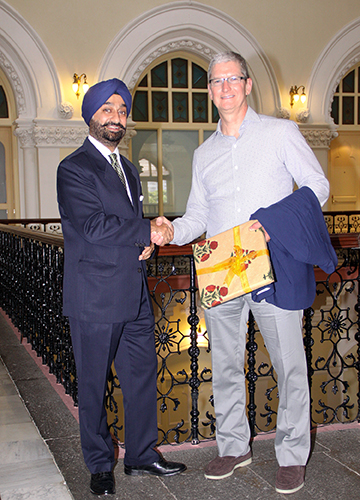As imposing as the Gateway of India―the archway that was erected in 1924 to welcome George V, the first British monarch to arrive on Indian shores―is its neighbour, the Taj Mahal Palace Hotel. One could say it has served as a more memorable guidepost, too, since it was built in 1903, two decades before the Gateway was conceived.
Then called the Taj Mahal Hotel, after India’s most famous monument of love, and built in the Indo-Saracenic style, it was the first to introduce the country’s famous hospitality to the rest of the world. It was the finest hotel east of the Suez Canal then and it transformed not just the face of Bombay, but also the image of India. The New York Times called it “a resplendent debut”, as it was Tata Group founder Jamsetji Tata’s first hotel under the aegis of the Indian Hotels Company Limited (IHCL). On December 16, 2023, this magnificent edifice celebrates its 120th birthday.
The hotel continues to earn its place in history. Maharajas considered it their second home. During the freedom movement, leaders like Muhammed Ali Jinnah and Sarojini Naidu held court in its suites. Mahatma Gandhi and Jawaharlal Nehru were both visitors, as were writers Somerset Maugham and Aldous Huxley who supported India’s independence. In fact, independent India’s first speech to industry leaders took place at this hotel.
The Taj Mahal Hotel’s list of eminent guests is probably rivalled only by the Rashtrapati Bhavan―King Charles III, Margaret Thatcher, the Clintons, Jacqueline Onassis, David Rockefeller, the Obamas, George Bernard Shaw, Irving Stone, Barbara Cartland, Richard Attenborough, Mick Jagger, Yehudi Menuhin, Andrew Lloyd Weber, Brad Pitt, Angelina Jolie, Madonna and the prince and princess of Wales William and Catherine, too, had stayed at the Taj.
“This building houses not just the history of the Taj hotels and of India, but also the history of the world,” says Puneet Chhatwal, managing director and chief executive officer of IHCL. “This is natural given our 120-year history of being an iconic crown jewel of India.”
The hotel was the first in India to have a licenced bar (its famous Harbour Bar has the licence number 1) and electric elevators. And it introduced jazz and cabaret to India.
IHCL went on to be counted among the finest luxury hotel chains in the world. It began by opening its doors to India’s palaces. It opened up tourism in states like Rajasthan, Kerala and Goa, the Andamans and, more recently, the northeast. Iconic properties in the UK and the US followed, too. What started as a single hotel in 1903 is now a hospitality ecosystem with world-class service and a bouquet of properties across luxury and business hotels. IHCL today has a portfolio of 274 hotels, including 82 under development, across four continents and 11 countries. It is India’s largest hospitality company by market capitalisation. This year, Brand Finance named Taj India’s Strongest Brand.
SeleQtions is a collection of hotels under the IHCL umbrella, along with the upscale Vivanta, a lean luxe segment with Ginger, and a charming portfolio of private bungalows and villas in picturesque spots called amã Stays & Trails.
This year, IHCL has also announced its 104th luxury hotel property. “We are among the top three luxury hotel chains of the world, and the fastest growing in this space,” says Chhatwal. “These include our iconic assets like The Pierre in New York, or the St James Court and the Taj 51 Buckingham Gate in London. There are three hotels in operation in Dubai, and one under development. We are in all the neighbouring countries, except in Kathmandu, Nepal.”
Chhatwal says the next decade will see the chain develop a strong presence in Singapore, Thailand, Vietnam, Indonesia and maybe a few properties in continental Europe. “Personally, this gives me a sense of pride,” he says. “It gives me a sense of accomplishment. I believe that when you serve the Taj, you serve the nation. Because that’s exactly what we do. The majority of the G20 events took place at a Taj property. The host of the B20 was the Taj Palace in New Delhi, a lot of the dignitaries were staying both at the Taj Palace here and the Taj Mansingh, too.”
IHCL’s service to the nation was especially evident during the Covid-19 pandemic. “If you are the largest hospitality ecosystem of India, automatically what you are doing is in alignment with the strategy of the national leadership,” Chhatwal explains. “This becomes like a service to the nation if you are at the forefront hosting 1,20,000 beds a night for frontline workers, or six million meals (during Covid as well as the Assam floods), all hosted through the Taj Public Service Welfare Trust, which was formed in the aftermath of the 2008 terror attacks.”
The group worked closely with the Brihanmumbai Municipal Corporation and government hospitals in Mumbai and took care of frontline staff as well as migrant workers. “There were 12 to 13 hospitals we were catering to,” Chhatwal says. “This is all a part of the DNA of the group; we have always been large-hearted,”.
When Chhatwal joined the group in 2017, IHCL was a loss-making entity. He turned it around in a year, reporting a profit of Rs101 crore. When the hotel industry worldwide was hit by the pandemic, the hospitality industry reported major losses. But IHCL recovered by 2022-23 itself, recording its highest-ever profit of Rs1,003 crore.
How did he manage the crisis? “We have been blessed to have gone to good schools, colleges, and business schools,” says Chhatwal. “They teach you sensitivity; what happens if your revenue drops by 20 per cent to 30 per cent. But I don’t think anybody ever taught what happens if your revenue becomes zero. When the lockdown was announced at that time, I don’t think anybody ever thought how long it would last. If we had known in the beginning that this was going to go on for two years, a lot of us would have given up. Because we thought it was going to come to an end, we started working before the second lockdown came. That is what kept us going. The leadership of the Tata Group chairman was critical in this space. So there was no panic reaction. For example, we didn’t put any of our full-time employees in furlough. I will say 200 people of the top management took a voluntary salary cut to support contractual employees. We did whatever we could for the people who were directly or indirectly associated with us.”
The pandemic was also a wake-up call for resetting costs. “We invented luxury home stays with amã. We went into luxury home delivery with Qmin. It kept evolving and everybody was kept busy. We opened in Mumbai in May 2020. Then we extended to four cities in the next month, then to 10 or 12 in the next 12 months. So it is not always just about revenue or profitability, but the system was busy, something was always happening. Today, even that has evolved as a business. The all-day dining of all Ginger hotels will be called Qmin. Today, we have 40 operational outlets for Qmin. It will soon have 100 outlets. So, 100 Qmin restaurants that started from an idea of home delivery,” says Chhatwal.
All of this is part of Chhatwal’s strategy to keep IHCL iconic as well as profitable. His call to action was called Ahvaan 2025, and he is making the chain asset light.
When the Taj Mahal Palace Hotel turned 100, a renovation programme was put into place. International architects were invited to work with local artisans and hotel staff to bring about a loving update. The Taj Mahal Palace has collected some 4,000 paintings and works of art―possibly the largest collection in the country after Air India’s, which is yet to be archived. More than 250 of these are museum-quality pieces. Giant Belgian chandeliers and the finest Bastar tribal art have been curated and displayed together. Anglo-Indian inlay chairs, Goan Christian artefacts, Mughal jaali-inspired designs and contemporary sculpture―the hotel is a veritable living museum of the finest talents.
The 120-year celebrations promise to be as iconic. It will start on December 17, with a sound and light show at the Gateway of India. A year of celebrations across all hotels will follow.
“We call March 24, which was otherwise the worst day for the hotel sector, a TAJNESS day. We will celebrate it across our hotels from breakfast to dinner. All guests, employees and stakeholders will be involved in the celebration. TAJNESS stands for Trust, Awareness and Joy, our three pillars of hospitality,” says Chhatwal. Musical evenings, black-tie dinners and the like will be hosted across major Indian cities.
A luxury brand celebrating 120 years also shows how the hotel has held on to both strings of legacy as well as modernity. The Taj Mahal Palace hotel as well as the IHCL group are constantly evolving. Social media promotions are a serious business now. Newer concepts to timeless spaces are constantly being planned. “Whether we did a Wasabi a few decades ago or a Souk, our restaurants are thriving. The once popular Zodiac Grill also comes back as a weekend Chambers (one of the most sought-after private clubs) dining. Now we will be going into renovation with the Chambers. We did the entire pool side and a new spa. We will be doing a new salon. We will be doubling the size of Chambers and taking a floor above that,” says Chhatwal.
The Taj Mahal Palace and IHCL are focused on an inclusive and sustainable growth, and to be major drivers to make India a top travel and tourism economy. The latest World Travel and Tourism Council (WTTC) report expects the sector to create 126 million jobs globally with at least 20 per cent of these coming from the Indian subcontinent.
“At the end of the day, you are still dealing with human beings, you are still dealing with emotions, you are still dealing with the experience,” says Chhatwal. “The experiences are getting more and more in focus than just the brick and mortar.”





